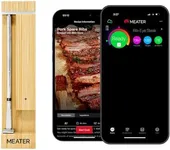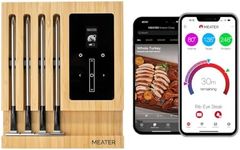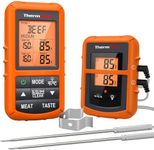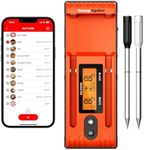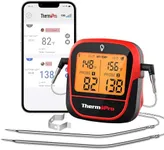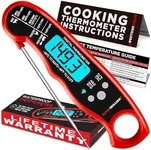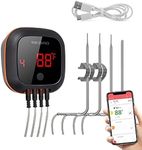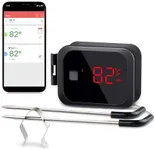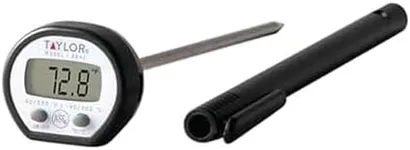Buying Guide for the Best Leave In Meat Thermometer
Choosing the right leave-in meat thermometer can make a significant difference in your cooking experience, ensuring that your meat is cooked to perfection every time. A leave-in meat thermometer is designed to stay in the meat while it cooks, providing continuous temperature readings. This helps you avoid undercooking or overcooking your meat, ensuring it is safe to eat and delicious. When selecting a leave-in meat thermometer, consider the following key specifications to find the best fit for your needs.Temperature RangeThe temperature range of a leave-in meat thermometer indicates the minimum and maximum temperatures it can measure. This is important because different types of meat require different cooking temperatures. For example, poultry needs to reach a higher internal temperature than beef. A thermometer with a wide temperature range (e.g., 32°F to 572°F) is versatile and can be used for various types of meat and cooking methods. If you frequently cook a variety of meats, opt for a thermometer with a broad range. If you primarily cook one type of meat, ensure the thermometer covers the necessary temperature for that meat.
AccuracyAccuracy refers to how close the thermometer's reading is to the actual temperature of the meat. This is crucial for ensuring your meat is cooked safely and to your desired doneness. High accuracy (within ±1-2°F) is ideal for precise cooking. If you are a perfectionist or cook for people with specific dietary needs, prioritize a highly accurate thermometer. For general home cooking, a slightly less accurate thermometer (within ±3-5°F) may still be sufficient.
Probe LengthThe probe length determines how deep the thermometer can be inserted into the meat. This is important for getting an accurate reading, especially for larger cuts of meat. Longer probes (6 inches or more) are better for large roasts or whole poultry, while shorter probes (around 4 inches) are suitable for smaller cuts like steaks or chicken breasts. Choose a probe length based on the types of meat you cook most often. If you cook a variety of sizes, a medium-length probe (5-6 inches) offers versatility.
Display TypeThe display type refers to how the temperature reading is shown on the thermometer. Common types include digital displays and analog dials. Digital displays are easier to read and often come with additional features like backlighting and preset temperature settings. Analog dials are simpler and do not require batteries. If you prefer convenience and additional features, go for a digital display. If you want a straightforward, no-fuss option, an analog dial may be sufficient.
DurabilityDurability refers to how well the thermometer can withstand regular use and exposure to heat and moisture. This is important for ensuring the thermometer lasts a long time and continues to provide accurate readings. Look for thermometers made with high-quality materials like stainless steel probes and heat-resistant cables. If you cook frequently or use the thermometer in high-heat environments like grills or smokers, prioritize a durable model. For occasional use, a less robust thermometer may still meet your needs.
Additional FeaturesAdditional features can enhance the functionality and convenience of a leave-in meat thermometer. These may include wireless connectivity, programmable alarms, and multiple probes. Wireless thermometers allow you to monitor the temperature remotely, which is useful for long cooking times. Programmable alarms can alert you when the meat reaches a specific temperature. Multiple probes let you monitor different pieces of meat simultaneously. Consider which features will make your cooking experience easier and more enjoyable. If you like high-tech gadgets, look for thermometers with advanced features. If you prefer simplicity, a basic model may be more suitable.
